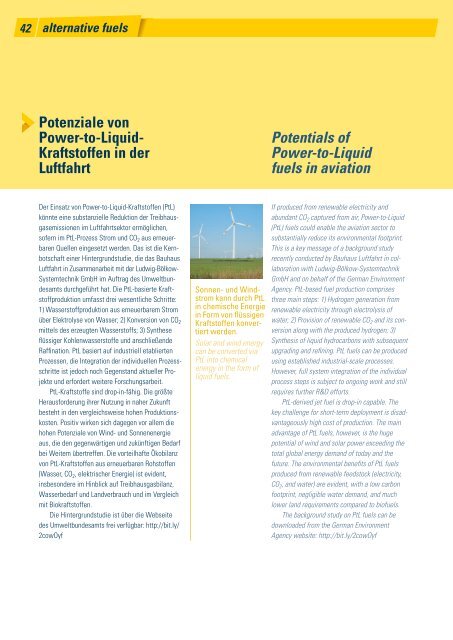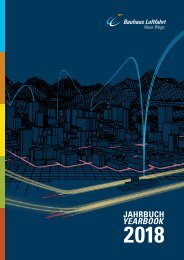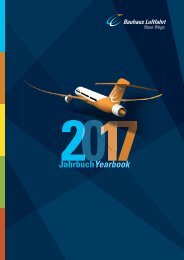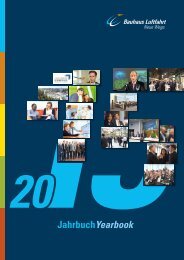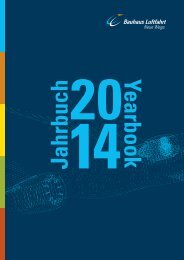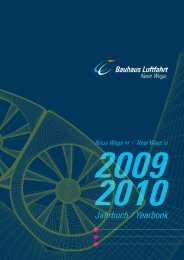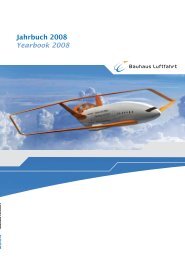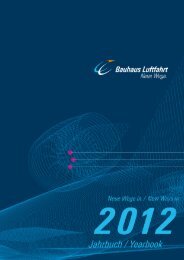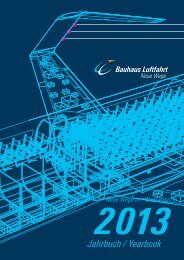Jahrbuch Bauhaus Luftfahrt 2016
Erfolgreiche ePaper selbst erstellen
Machen Sie aus Ihren PDF Publikationen ein blätterbares Flipbook mit unserer einzigartigen Google optimierten e-Paper Software.
42 alternative fuels<br />
Potenziale von<br />
Power-to-Liquid-<br />
Kraftstoffen in der<br />
<strong>Luftfahrt</strong><br />
Potentials of<br />
Power-to-Liquid<br />
fuels in aviation<br />
Der Einsatz von Power-to-Liquid-Kraftstoffen (PtL)<br />
könnte eine substanzielle Reduktion der Treibhausgasemissionen<br />
im <strong>Luftfahrt</strong>sektor ermöglichen,<br />
sofern im PtL-Prozess Strom und CO 2 aus erneuerbaren<br />
Quellen eingesetzt werden. Das ist die Kernbotschaft<br />
einer Hintergrundstudie, die das <strong>Bauhaus</strong><br />
<strong>Luftfahrt</strong> in Zusammenarbeit mit der Ludwig-Bölkow-<br />
Systemtechnik GmbH im Auftrag des Umweltbundesamts<br />
durchgeführt hat. Die PtL-basierte Kraftstoffproduktion<br />
umfasst drei wesentliche Schritte:<br />
1) Wasserstoffproduktion aus erneuerbarem Strom<br />
über Elektrolyse von Wasser; 2) Konversion von CO 2<br />
mittels des erzeugten Wasserstoffs; 3) Synthese<br />
flüssiger Kohlenwasserstoffe und anschließende<br />
Raffination. PtL basiert auf industriell etablierten<br />
Prozessen, die Integration der individuellen Prozessschritte<br />
ist jedoch noch Gegenstand aktueller Projekte<br />
und erfordert weitere Forschungsarbeit.<br />
PtL-Kraftstoffe sind drop-in-fähig. Die größte<br />
Herausforderung ihrer Nutzung in naher Zukunft<br />
besteht in den vergleichsweise hohen Produktionskosten.<br />
Positiv wirken sich dagegen vor allem die<br />
hohen Potenziale von Wind- und Sonnenenergie<br />
aus, die den gegenwärtigen und zukünftigen Bedarf<br />
bei Weitem übertreffen. Die vorteilhafte Ökobilanz<br />
von PtL-Kraftstoffen aus erneuerbaren Rohstoffen<br />
(Wasser, CO 2 , elektrischer Energie) ist evident,<br />
insbesondere im Hinblick auf Treibhausgasbilanz,<br />
Wasserbedarf und Landverbrauch und im Vergleich<br />
mit Biokraftstoffen.<br />
Die Hintergrundstudie ist über die Webseite<br />
des Umweltbundesamts frei verfügbar: http://bit.ly/<br />
2cowOyf<br />
Sonnen- und Windstrom<br />
kann durch PtL<br />
in chemische Energie<br />
in Form von flüssigen<br />
Kraftstoffen konvertiert<br />
werden.<br />
Solar and wind energy<br />
can be converted via<br />
PtL into chemical<br />
energy in the form of<br />
liquid fuels.<br />
If produced from renewable electricity and<br />
abundant CO 2 captured from air, Power-to-Liquid<br />
(PtL) fuels could enable the aviation sector to<br />
substantially reduce its environmental footprint.<br />
This is a key message of a background study<br />
recently conducted by <strong>Bauhaus</strong> <strong>Luftfahrt</strong> in collaboration<br />
with Ludwig-Bölkow-Systemtechnik<br />
GmbH and on behalf of the German Environment<br />
Agency. PtL-based fuel production comprises<br />
three main steps: 1) Hydrogen generation from<br />
renewable electricity through electrolysis of<br />
water; 2) Provision of renewable CO 2 and its conversion<br />
along with the produced hydrogen; 3)<br />
Synthesis of liquid hydrocarbons with subsequent<br />
upgrading and refining. PtL fuels can be produced<br />
using established industrial-scale processes.<br />
However, full system integration of the individual<br />
process steps is subject to ongoing work and still<br />
requires further R&D efforts.<br />
PtL-derived jet fuel is drop-in capable. The<br />
key challenge for short-term deployment is disadvantageously<br />
high cost of production. The main<br />
advantage of PtL fuels, however, is the huge<br />
potential of wind and solar power exceeding the<br />
total global energy demand of today and the<br />
future. The environmental benefits of PtL fuels<br />
produced from renewable feedstock (electricity,<br />
CO 2 , and water) are evident, with a low carbon<br />
footprint, negligible water demand, and much<br />
lower land requirements compared to biofuels.<br />
The background study on PtL fuels can be<br />
downloaded from the German Environment<br />
Agency website: http://bit.ly/2cowOyf


